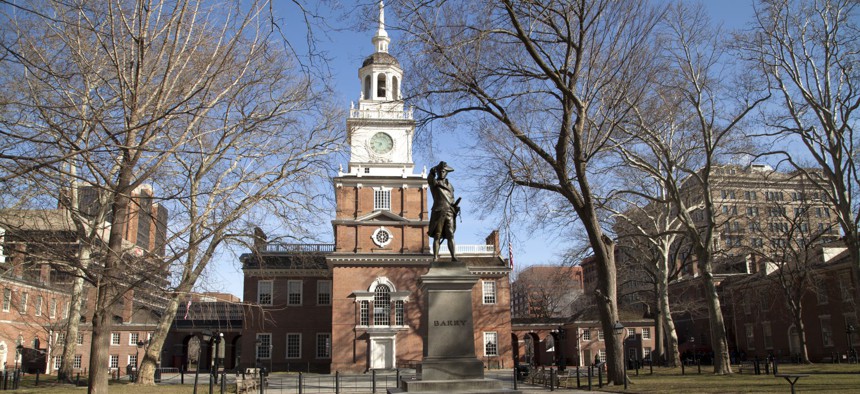Laying the Groundwork for a Second Constitutional Convention

Independence Hall in Philadelphia Shutterstock
A primer on the effort underway to devolve federal power back to the states.
When the states convened the 1787 Constitutional Convention that formed the modern United States Constitution, Patrick Henry of “Give me liberty, or give me death” fame turned down his invitation. He famously stated he “smelt a rat in Philadelphia, tending toward the monarchy.”
At the time, there was an assumption this convention was to revise the “Articles of Confederation” that bound the nation together. After three months, the conveners emerged from a veil of secrecy with their proposal to scrap the governing document for a new Constitution—one that provided for a dramatic growth in federal power, shaping the United States as we know it today.
This month, Wisconsin Gov. Scott Walker became the latest elected official to publicly call for an “Article V” constitutional convention to be convened by the states. This new constitutional convention’s aim, however, would be to devolve federal power back toward the states.
Walker’s call was not sudden, novel, or unique, but part of a building movement that has a real political path forward.
The Groundwork
Article V of the Constitution outlines two processes for proposing amendments. The first is well known and taught in every civics class: Congress passes an amendment by a two-thirds vote in each chamber, as it has been done since the convention of 1787. The other option—one not yet taken and rarely discussed outside of the nerdiest of government geeks—is a convention of the states that circumvents the Congress’ role. For a constitutional convention to be convened, it requires two-thirds of states (34 of the 50) to call for it. In both situations, three-quarters of the states (38) must ratify its results.
The recent political foundations for a new constitutional convention began quite a few years ago. In 2011, Harvard University hosted the Constitutional Convention Conference (well-coined as “ConConCon”). It was led by strange bedfellows Mark Meckler, co-founder of the conservative populist Tea Party Patriots, and Harvard professor Larry Lessig, a liberal political activist interested in a constitutional convention to enact campaign finance reform and electoral reform.
The idea caught on among political conservatives. By 2013, there was enough interest that 100 state legislators from 32 states gathered at George Washington’s Mount Vernon estate to begin the groundwork for a national movement.
Those legislators met while in the area for the American Legislative Exchange Council (ALEC) conference. ALEC is a non-profit “partnership of America's state legislators and members of the private sector” that writes model legislation for state legislators that “advance free-market enterprise” and “limited government.”
In 2015, ALEC drafted model legislation for its state legislators that would “call an Article V Convention limited to proposing amendments to that will impose fiscal restraints on the federal government; limit the power and jurisdiction of the federal government and limit the terms of office for federal officials and members of Congress.”
ALEC is known for its tremendous success in getting model legislation passed at the state level. With over a quarter of state legislators belonging and a record of success, their influence is well documented. ALEC’s strategic document outlines a study that shows ALEC members surpassed all Democratic legislators in passing legislation by a two-to-one ratio. In 2016, ALEC published, “Article V: A Handbook for State Lawmakers,” a playbook and guide to such an article V constitutional convention.
When Wisconsin Gov. Scott Walker became the latest conservative leader to join the call for a new constitutional convention, he was not alone. He was joining other governors, such as Texas’ Greg Abbott, who has laid out a total of nine recommended amendments ranging from prohibiting federal regulations that preempt state law to allowing a two-thirds majority of the states to overturn any federal law or supreme court decision.
Gov. John Kasich of Ohio has also endorsed a convention, albeit focused on the passage of a balanced budget amendment that would constrain Congress’ spending to the yearly revenue accrued. U.S. Sen. Marco Rubio of Florida went so far as to pen an op-ed in USA Today as part of his presidential campaign calling for “a convention of states to amend the Constitution and restore limited government”—an op-ed the newspaper’s editorial staff replied to in their own piece, “Marco Rubio's very bad idea.”
There are also a number of outside conservative groups beyond ALEC pushing for an “Article V” Convention. That includes newer organizations like Convention of the States—led by the aforementioned Tea Party Patriots co-founder Mark Meckler—as well as more traditional conservative standby organizations like Freedomworks. These two organizations, along with ALEC, represent the sort of infrastructure that has been successful in coordinating national conservative advocacy movements and grassroots activism, ensuring national campaigns have the local support necessary to move them forward.
Calling the Convention: By the Numbers
To enact a constitutional convention, two-thirds of the states—that would be 34—must call for one via legislation. (Sorry citizens of the District of Columbia and U.S. territories, you will not be represented). If the political will exists and traction continues to grow, the opportunity to make a constitutional convention a reality is not far-fetched.
Since President Obama took office, Republicans have picked up over 1,000 additional state legislative seats, ultimately gaining control of 67 of the 98 partisan state legislative chambers in the United States (more on Nebraska’s weird deal in a moment).
The GOP will control both chambers in a total of 32 states in 2017.
While Republicans only hold the governorship in 25 of those states, is this the sort of legislation a Democratic governor will want to utilize political power on a veto? In certain states, perhaps. In other states, that veto may be costly from a political capital standpoint. In others, such as North Carolina, it could be overridden or tucked into crucial legislation.
In addition to those 32, there are other states that shouldn’t be counted out. Nebraska is a prime target. Its legislature is unique in two ways: it is “non-partisan,” with people not running with a party affiliation; also, it’s unicameral, meaning there is one chamber instead of two. Being non-partisan for election purposes does not mean many of its members would not affiliate themselves with this movement.
Maine, with firebrand conservative Gov. Paul LePage and two closely divided legislatures could also be a target. Alaska also is in play. Although a coalition of Democrats, Independents, and Republicans control the Alaska House of Representatives, the state has Republican majorities in both chambers. While Alaska Gov. Bill Walker is an Independent, he has previously identified as a Republican.
By this count, in 2017 alone there are 35 legislatures which could be solid targets for advocates of a constitutional convention that devolves power from the federal government. As this state legislation would remain on the books unless repealed, advocates have time—the magic number of 34 could be reached over a number of years as state legislative majorities ebb and flow.
At the Convention
Congressional amendments to the constitution have an onerous process for passage. By Supreme Court Justice Antonin Scalia’s assessment, the process is so difficult that less than two percent of the populace could prevent a constitutional amendment.
When Scalia made that calculation public in 2014, he prefaced those remarks with the statement, “I certainly would not want a Constitutional Convention. I mean whoa. Who knows what would come out of that?” That’s because once a constitutional convention is called, it is unclear that there are any constraints on what changes could be proposed.
In 1787, states gave varying, typically vague reasons for calling for a constitutional convention. As seen in the language from ALEC, a vague mandate would be likely if another was called in the coming years. What comes out of a convention could be anything the delegates choose to address that can be tangentially attached to that mandate, and representatives will have some leeway on what can be included in that mandate.
ALEC, Convention of the States, and other conservative groups dispute Scalia’s assertion that a constitutional convention could end up being a “runaway convention” that makes dramatic changes to our nation. As there is no significant case law or precedent, though, it’s quite unclear how much leeway the convention would have.
After the Convention
After the convention and its recommendations comes the hard part: a ratification by three-fourths of the states—either by their legislatures or state ratifying conventions, as chosen by Congress. While it would be a high bar to get 38 states to ratify the results, no time limit exists for ratifying amendments unless specifically set by those proposing it. The 27th amendment to the constitution waited 202 years, 7 months, and 10 days before passing in 1992. It was originally proposed along with the Bill of Rights.
Even when a deadline has been set for an amendment, it still can be extended. Congress added three years of life to the Equal Rights Amendment with a simple majority vote in 1979 before it was ultimately declared dead in 1982.
While ratification of any changes to the constitution are always a long-shot, it’s hard to ignore the fact that political will, organization, and opportunity have aligned in a way that is rare in American politics.
If 2016 election taught us anything, we certainly shouldn’t rule it out.
RELATED at Route Fifty:
Mitch Herckis is Senior Program Director at Government Executive’s Route Fifty and is based in Washington, D.C.
NEXT STORY: Chicago Mayor Releases Emails From Personal Account; Is Utah’s New Prison Too Big?






